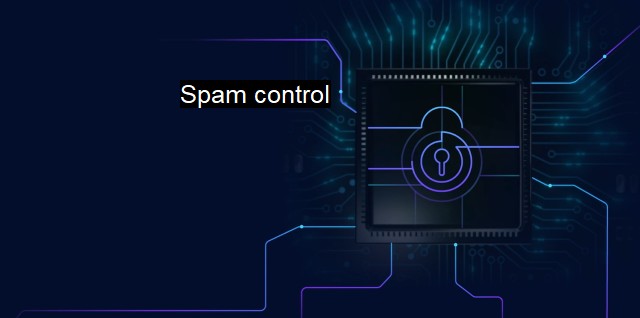What is Spam control?
The Importance of Spam Control in Cybersecurity and Antivirus Protection: Techniques and Strategies to Counteract Unsolicited Emails
Spam control is an essential aspect of cybersecurity, dedicated to the prevention, detection, and mitigation of unsolicited or harmful electronic messages, more commonly known as "spam". With the exponential growth of the internet and digital communication, spam has become a significant nuisance and potential cybersecurity threat, prompting the development of several spam control measures.Spam refers to unsolicited bulk messages disseminated through electronic messaging systems. Although most people associate spam with email, it can appear in various forms, such as instant messages, social media posts, unwanted pop-ups, and even phone text messages. Spam typically involves redundant or identical messages sent to numerous recipients. Many spam messages are harmless marketing attempts; others may contain malicious software (malware) or phishing attempts intended to compromise a user's privacy, security, and device functionality.
Spam control, therefore, is the collection of mechanisms, protocols, and procedures designed to limit the prevalence, impact, and risks associated with spam. It includes various practices ranging from different filtering methods and user awareness training, to more complex processes such as network-level defense mechanisms and actions carried out by Internet Service Providers (ISPs).
One predominant form of spam control is spam filters. This technology is typically implemented in email software or as part of the functionalities of an antivirus program. Spam filters use predefined algorithms or learning algorithms to categorize email based on their content, sender's reputation, and other specific attributes. A robust spam filter should be capable of safely filtering out most spam without blocking legitimate communication unintentionally.
Similarly, firewalls often serve as another line of defense against spam, blocking incoming and outgoing traffic based on various criteria. For instance, most modern firewalls allow system administrators to block specific IP addresses known for frequent spam dissemination.
Machine learning algorithms, a relatively new form of spam-control technology, offers proactive protection. Drawing on a database of known spam messages, this approach compares incoming emails in real-time, examining language patterns, message source data and subject lines to assess potential threats and approximate the likelihood of an email being spam. Over time, these algorithms learn and adapt to the current spam landscape, providing increasingly accurate protection.
Network administrators also play a crucial role in spam control, managing email servers to deny email traffic to known spammers and setting up restrictions or safeguards that prevent malicious email reception. They may also equip networks with specialized software to scan incoming emails for common spam characteristics.
ISPs can significantly contribute to spam control as well. They can report spam and terminate services to customers who send spam messages. ISPs can also implement network-level email filtering mechanisms that analyze and filter all traffic passing through their networks, contributing significantly to reducing spam email on a macroscale.
From a user's perspective, spam control could simply mean regularly updating antivirus software and being aware of and stringent about sharing personal details or opening suspicious-looking emails. Cybersecurity education for users has proven to be very effective in reducing the risk posed by spam.
Another dimension of spam control revolves around legislation. Many countries have laws against spamming and have established severe penalties for violations. Legal pressure supplemented with real cybersecurity measures often discourages potential spammers.
Spam control is a crucial part of a broader cybersecurity strategy, integrating various preventative, detective, and corrective controls practically adapting to the shifting landscape of threats. Protection against spam, therefore, should not be a singular action but a multi-faceted approach that combines technological and human interventions. In an increasingly interconnected world, vigorous spam control practices signify the thin, protecting layer standing between us and a potential deluge of dangerous and disruptive unwanted electronic communications.

Spam control FAQs
What is spam control?
Spam control refers to the various measures and techniques that are used to prevent and control the distribution of unwanted and unsolicited email messages and other forms of electronic communication.Why is spam control important in cybersecurity?
Spam control is important in cybersecurity because spam emails and messages can contain malicious links and attachments that can compromise the security of computer systems and networks.What are some common spam control techniques?
Some common spam control techniques include filtering, blacklisting, whitelisting, and content analysis. Filtering involves identifying and blocking spam messages based on their content and other characteristics, while blacklisting and whitelisting involve restricting or allowing access to specific IP addresses, domains, and email senders. Content analysis is used to analyze the content of emails and other messages for potential spam or malicious content.How do antivirus programs help with spam control?
Antivirus programs can help with spam control by scanning incoming emails and other messages for potential malware and other types of malicious content. They can also block access to known spam and phishing websites, and detect and remove malicious attachments from emails and other types of electronic communication.| | A | | | B | | | C | | | D | | | E | | | F | | | G | | | H | | | I | | | J | | | K | | | L | | | M | |
| | N | | | O | | | P | | | Q | | | R | | | S | | | T | | | U | | | V | | | W | | | X | | | Y | | | Z | |
| | 1 | | | 2 | | | 3 | | | 4 | | | 7 | | | 8 | | |||||||